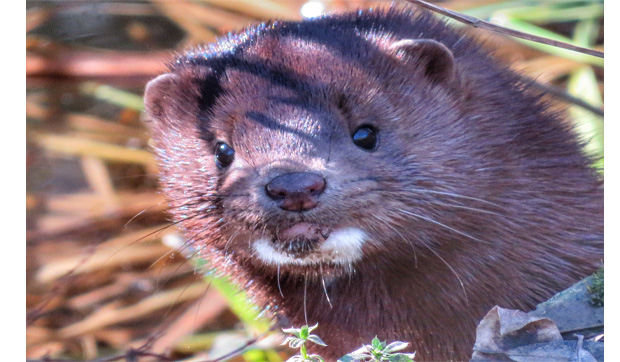With egg-laying season just around the corner, American mink will be out and about, hunting for active waterfowl nests.
Good Natured: Mink-n-Eggs
March 24, 2023
Next weekend, April 1, the St. Charles Park District will hold its annual Easter Egg Hunt at Pottawatomie Park. Thousands of eggs, hundreds of kids. A sugar-fueled good time will be had by all!
While that egg hunt will be over in a matter of minutes, another and much longer one will just be getting started. We’re on the verge of waterfowl nesting season, and ducks and geese throughout northern Illinois are staking out territories, preparing nests and, yep, laying eggs.
Which reminds me, (as I’m sure it did you lol) that this is a great time of year to catch a glimpse of a mink.
That’s right, mink. Those same animals you see draped on collars and coats, accompanied by silk scarves and maybe a spritz of something by Chanel, actually are fairly common residents of our local strea. While they tend to steer clear of colored eggs and organized hunts, they do frequent streambanks, ponds and wetlands throughout the area, hunting prey. Their diet varies seasonally but, in spring, is heavy on eggs–particularly those of waterfowl.
Our local ducks and geese produce an average of one egg per day, and may produce a dozen eggs or more in a two-week period. But they do not begin incubating until the entire clutch has been laid. Until then, Mom often will leave her nest unattended for hours at a time, having covered the eggs with down, while she goes out foraging for a meal of her own.
Talk about opportunity. Eggs by the dozen, all of them perfectly fine food; none of them able to put up a fight. When you think about things from the mink’s point of view, what could be an easier meal?
Outfitted with a superb sense of smell, mink are well adapted to finding such food sources, and are willing to go to extraordinary lengths to obtain them. I remember watching one industrious mink clamber 15 feet up an oak tree and slip inside an active wood-duck nest box. When it finally emerged, the mink was smeared with egg yolk and tiny bits of shell flecked its fur. These animals can’t smile but, if they could, I’m sure that one would have been sporting a big ol’ egg-eating grin.
Of course, mink can’t live by eggs alone. Ranking tops among our area’s most proficient predators, these mammals feed on a wide range of prey, including crayfish, fish, frogs, turtles, rabbits and rodents-including large rodents, like muskrats and young beavers; medium-sized rodents like squirrels and chipmunks; and small rodents, like mice and voles.
Although their hunting habits are fascinating, at least to naturalists, mink undoubtedly are most famous for their fur. Their coat is characterized by long, lustrous guard hairs over a
soft, dense coat of underfur. Wild mink vary in color from chocolate brown to near black above, with somewhat lighter brown fur below. Most also have a white spot on the chin, which may continue along the underside. Each of these marks is unique, and can be used to distinguish one mink from another.
Despite their association with luxury, mink are fairly typical members of the weasel, or mustelid, family. They possess a pair of scent glands under the tail, the odor of which is quite strong. In fact, the common name “mink” stems from the Swedish maenk which, according to some sources, means “stinking animal from Finland.”
With egg-laying season nearly upon us, mink will be on the move, taking advantage of the bountiful buffet. If you find yourself near a local waterway or wetland, especially in the early morning or late evening, keep your eyes peeled. Look for a dark, thin-bodied animal, low to the ground and about two feet long.
When hunting, a mink will prowl stealthily. In fact, it’s often easier to spot one if you stay still and let it do the moving. On the other hand, if a mink is startled or chasing prey, it bounds-that is, its long, slinky body moves much like, well, a Slinky. Front feet land, then hind feet come down in virtually the same spot, just as the front feet take off again.
Mink are good swimmers, so watch the water as well. Don’t be surprised though if the sinuous form you’ve trained your eyes on suddenly disappears. Mink are good divers too, and can stay underwater for several minutes at a time.
They slink, they stink, they disappear in a wink. To a naturalist, they’re more fun than an egg hunt…they’re mink!
Pam Otto is the outreach ambassador for the St. Charles Park District. She can be reached at potto@stcparks.org.

